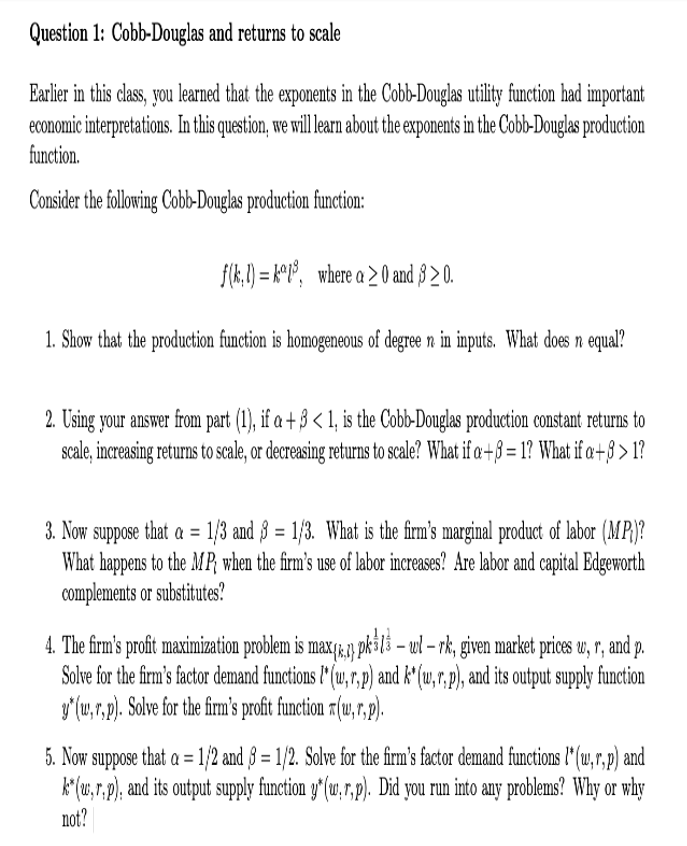Consider the following Cob-Douglas production function: f(k.1) = K°P°, where a 20 and > 0. 1. Show that the production function is homogeneous of degree n in inputs. What does n equal? 2. Using your answer from part (1), if a + 3 < 1, is the Cobb-Douglas production constant returns to scale, increasing returns to scale, or decreasing returns to scale? What if a+8 = 1? What if a+8 > 1? 3. Now suppose that a = 1/3 and = 1/3. What is the firm's marginal product of labor (MP)? What happens to the MP, when the firm's use of labor increases? Are labor and capital Edgeworth complements or substitutes?
Consider the following Cob-Douglas production function: f(k.1) = K°P°, where a 20 and > 0. 1. Show that the production function is homogeneous of degree n in inputs. What does n equal? 2. Using your answer from part (1), if a + 3 < 1, is the Cobb-Douglas production constant returns to scale, increasing returns to scale, or decreasing returns to scale? What if a+8 = 1? What if a+8 > 1? 3. Now suppose that a = 1/3 and = 1/3. What is the firm's marginal product of labor (MP)? What happens to the MP, when the firm's use of labor increases? Are labor and capital Edgeworth complements or substitutes?
Chapter9: Production Functions
Section: Chapter Questions
Problem 9.5P
Related questions
Question

Transcribed Image Text:Question 1: Cobb-Douglas and returns to scale
Earlier in this class, you learned that the exponents in the Cobb-Douglas utility function had important
economic interpretations. In this question, we will learn about the exponents in the Cob-Douglas production
function.
Consider the following Cobb-Douglas production function:
f(k.1) = k*P°, where a > 0 and 8 > 0.
1. Show that the production function is homogeneous of degree n in inputs. What does n equal?
2. Using your answer from part (1), if a + 3 < 1, is the Cobb-Douglas production constant returns to
scale, increasing returns to scale, or decreasing returns to scale? What if a +8 = 1? What if a+§ > 1?
3. Now suppose that a = 1/3 and 8 = 1/3. What is the firm's marginal product of labor (MP)?
What happens to the MP when the firm's use of labor increases? Are labor and capital Edgeworth
complements or substitutes?
4. The firm's profit maximization problem is max 1&,3) pk3l3 – ul – rk, given market prices w, r, and p.
Solve for the firm's factor demand functions l* (w,r,p) and k' (w,r,p), and its output supply function
y'(u,r,p). Solve for the firm's proft function r1(u,r,p).
5. Now suppose that a = 1/2 and § = 1/2. Solve for the firm's factor demand functions l* (u,r,p) and
k(w, r,p), and its output supply function y*(u,r,p). Did you run into any problems? Why or why
not?
Expert Solution
This question has been solved!
Explore an expertly crafted, step-by-step solution for a thorough understanding of key concepts.
This is a popular solution!
Trending now
This is a popular solution!
Step by step
Solved in 3 steps

Knowledge Booster
Learn more about
Need a deep-dive on the concept behind this application? Look no further. Learn more about this topic, economics and related others by exploring similar questions and additional content below.Recommended textbooks for you


Managerial Economics: Applications, Strategies an…
Economics
ISBN:
9781305506381
Author:
James R. McGuigan, R. Charles Moyer, Frederick H.deB. Harris
Publisher:
Cengage Learning



Managerial Economics: Applications, Strategies an…
Economics
ISBN:
9781305506381
Author:
James R. McGuigan, R. Charles Moyer, Frederick H.deB. Harris
Publisher:
Cengage Learning


Microeconomics: Principles & Policy
Economics
ISBN:
9781337794992
Author:
William J. Baumol, Alan S. Blinder, John L. Solow
Publisher:
Cengage Learning

